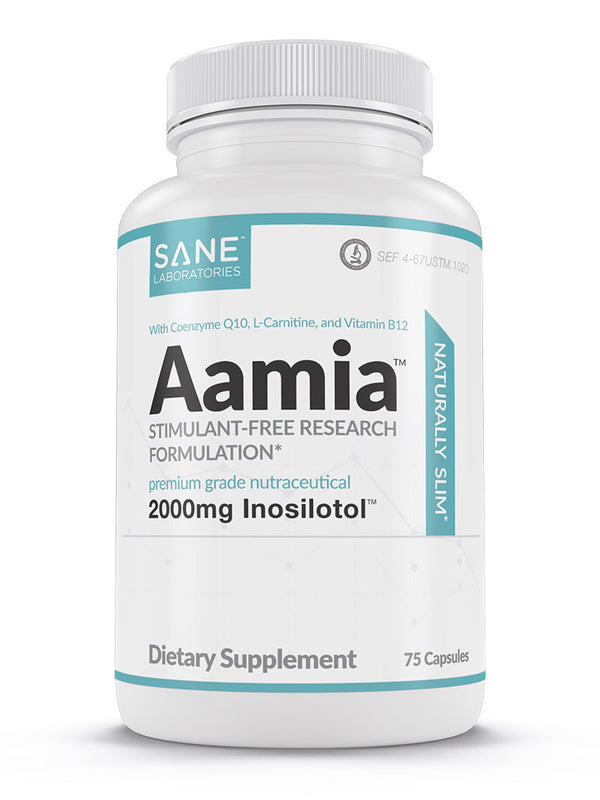Menopausal belly fat—or visceral fat—can feel like an unwelcome guest who just doesn’t know when to leave. But once you understand why it’s there, you’re better equipped to show it the door. During menopause, significant hormonal changes happen, especially a drop in estrogen levels. This shift can cause fat to move from areas like the hips and thighs and settle around the abdomen, leading to that stubborn belly fat so many women notice during this phase, which also increases the risk of cardiovascular disease.
Click here to learn more about Aamia® and to place your order now while supplies last!
Another thing to consider is age-related muscle loss, known as sarcopenia. As we lose muscle mass, our metabolism slows down, making weight gain easier and weight loss harder. Stress, which often ramps up during this time, doesn’t help either. It can spike cortisol levels—a hormone notorious for encouraging fat storage in the belly. And then there’s the sleep issue. Many women find sleep elusive during menopause, which messes with the hormones that regulate hunger and appetite, leading to more weight gain.
Lifestyle habits play a part, too. If you’ve been more sedentary and indulging in processed foods or sugary treats, these can sneakily contribute to belly fat. These foods can cause insulin resistance, a major factor in menopause-related weight gain. And let’s not forget about alcohol—those nightly glasses of wine can add up faster than you think, expanding your waistline along the way.
But here’s the silver lining: knowing what’s causing this can help you tackle it head-on. The next part of this article dives into easy, natural solutions to manage and reduce menopausal belly fat, so you can take back control of your health and confidence.
And hey, if you know someone who might find this helpful, feel free to share it with them.
Lifestyle Changes to Help Manage Menopause Belly Fat
Managing menopausal belly fat often comes down to making some thoughtful lifestyle changes. By tweaking your daily habits and routines, you can create a supportive environment that helps you shed that stubborn belly fat and keep it off. Incorporating aerobic exercise into your routine can be particularly effective for weight management and improving heart health.
Here are five practical lifestyle changes that could make a real difference:
1. Prioritize Quality Sleep
Getting enough good sleep is crucial not just for your waistline but for your overall well-being. Try to establish a regular sleep routine—head to bed and wake up at the same time every day. A calming bedtime ritual, without screens or gadgets, can help signal your body that it’s time to wind down.
Also, make sure your bedroom is your sleep sanctuary—keep it dark, cool, and quiet to improve your sleep quality.
2. Stay Hydrated
Water plays a big role in keeping your body running smoothly, including your metabolism. Aim to drink plenty of water throughout the day—shoot for at least eight glasses. Keeping a reusable water bottle handy is a great way to remind yourself to keep sipping.
Cutting back on sugary drinks and alcohol doesn’t just help with hydration; it also helps reduce belly fat.
3. Manage Stress Levels
Chronic stress is a known culprit when it comes to weight gain, especially around the belly. Carve out time for stress-busting activities each day. This could mean spending time outdoors, diving into a hobby you love, or practicing deep breathing exercises.
Having a solid support network of friends and family can also provide much-needed emotional comfort and help keep stress in check.
4. Create a Structured Daily Routine
A well-structured daily routine can help you avoid the chaos that often leads to unhealthy choices. Plan your day ahead, including your meals, breaks, and downtime, so you stay in control.
When you stick to a routine, you’re more likely to build healthy habits and less likely to make those impulsive decisions that contribute to weight gain.
5. Minimize Exposure to Environmental Toxins
Believe it or not, environmental toxins can mess with your hormones and contribute to weight gain. Try switching to natural cleaning products and cut back on plastics, especially for food storage. Also, be mindful of the personal care products you use—opt for those free of harmful chemicals.
These small changes can make a big impact on your hormonal balance and overall health.
Incorporating these lifestyle changes can go a long way in managing menopausal belly fat. Each tweak you make adds to a holistic approach to health, helping you build a solid foundation for achieving and maintaining a healthy weight.

Healthy Diet Changes to Help Manage Menopausal Belly Fat
Adjusting your diet to include a healthy diet can be a game-changer when it comes to tackling menopausal belly fat. Simple, mindful tweaks in what and how you eat can make a big difference in your body’s ability to manage weight. Many women may gain weight during menopause due to hormonal changes, lifestyle patterns, and metabolic shifts.
Here are five effective diet changes that could help you achieve a healthier waistline:
1. Focus on Protein-Rich Foods
Protein is your best friend when it comes to maintaining muscle mass and feeling full. Incorporate lean meats, fish, eggs, and plant-based proteins like beans and lentils into your meals. Aim to include protein in every meal to help keep your blood sugar levels steady and curb those pesky cravings.
Plus, protein-rich foods can give your metabolism a nice boost, helping you shed fat more efficiently.
2. Incorporate Healthy Fats
Not all fats are bad—in fact, healthy fats are essential for hormone balance and overall well-being. Look for sources of omega-3 fatty acids, such as salmon, chia seeds, and walnuts. Avocados, olive oil, and nuts are also great choices.
These healthy fats can help reduce inflammation and keep you feeling full, making it easier to manage your weight.
3. Increase Fiber Intake
Fiber is a superstar when it comes to digestion and keeping you full. Non-starchy vegetables like leafy greens, broccoli, and peppers are packed with fiber. Fruits like berries and citrus are also great sources, and they won’t cause major blood sugar spikes.
Adding fiber-rich foods to your diet can support weight loss and promote better digestive health.
4. Limit Added Sugars
Sugar can be a sneaky saboteur, leading to weight gain and throwing your hormones out of balance. Cut back on sugary drinks, candies, and baked goods. When you need a little sweetness, try natural sweeteners like stevia or monk fruit.
Being mindful of hidden sugars in processed foods and reading labels can make a big impact.
5. Practice Mindful Eating
Mindful eating is all about tuning in to your body’s signals. Take time to enjoy your meals without distractions, savoring each bite. Listen to your body’s cues for hunger and fullness, and try to stop eating when you’re satisfied, not stuffed.
This approach promotes better digestion and helps you develop a healthier relationship with food.
By incorporating these diet changes, you can take control of menopausal belly fat and support your overall health. Each adjustment brings you closer to a balanced, nutritious diet that helps maintain a healthy weight.
Physical Activity Changes to Help Manage Menopausal Belly Fat
Getting the right kind of physical activity can be a game-changer when it comes to managing menopausal belly fat and helping you lose belly fat. By mixing up your routine with targeted exercises, you can boost your metabolism, maintain muscle mass, and improve your overall fitness. Additionally, incorporating regular exercise and healthy dietary choices can make it easier to lose weight during menopause.
Here are four effective physical activity changes that could help you reach your health goals:
1. Incorporate Resistance Training
Building and maintaining muscle mass is key to keeping your metabolism humming. Try adding resistance training exercises like weightlifting, bodyweight exercises, or resistance band workouts into your weekly routine. Aim for two to three sessions each week, focusing on major muscle groups.
Resistance training not only boosts muscle strength but also improves bone density and supports fat loss.
2. Add High-Intensity Interval Training (HIIT) and Aerobic Exercise
High-intensity interval training (HIIT) involves alternating between short bursts of intense activity and periods of rest or low-intensity exercise. This type of workout can crank up your metabolism and burn fat more effectively than steady-state cardio. Incorporate HIIT sessions a few times a week with exercises like sprints, jumping jacks, or cycling.
HIIT is efficient and can significantly reduce body fat, especially that stubborn belly fat.
3. Engage in Regular Low-Impact Activities
Low-impact activities like walking, swimming, or cycling are easy on the joints and perfect for daily exercise. These activities help keep your overall physical activity level up without putting too much strain on your body. Try to get at least 30 minutes of low-impact exercise most days of the week.
Staying consistent with low-impact activities can boost your cardiovascular health and help with weight control.
4. Incorporate Flexibility and Balance Exercises
Flexibility and balance exercises can enhance your overall physical function and lower your risk of injury. Practices like yoga or tai chi are great for increasing flexibility, balance, and strength. Add these to your routine a few times a week to round out your more intense workouts.
Improving your flexibility and balance supports a well-rounded fitness regimen and contributes to your overall well-being.
By weaving these physical activity changes into your routine, you can effectively manage menopausal belly fat and boost your overall fitness. Each type of exercise brings its own unique benefits, helping you build a comprehensive approach to health and weight management.
Mental and Spiritual Changes to Help Manage Menopausal Belly Fat
When it comes to managing menopausal belly fat, it’s not just about the physical aspects—your mental and spiritual well-being are equally important. Taking care of your mind and spirit can go a long way in reducing stress, finding emotional balance, and supporting your overall health. Additionally, monitoring waist measurements is crucial to assess health risks associated with increased belly fat, such as cardiovascular disease, diabetes, and early death.
Here are four mental and spiritual changes that could help you on this journey:
1. Practice Mindfulness and Meditation
Mindfulness and meditation are powerful tools for reducing stress and finding your calm. Set aside a few minutes each day to focus on deep breathing, guided meditation, or simply sitting quietly and reflecting.
These practices can help keep stress hormones in check, which is key to avoiding weight gain around the belly. Plus, regular mindfulness can boost your emotional resilience and mental clarity.
2. Cultivate a Positive Mindset
A positive mindset can make a world of difference when it comes to your health and weight management. Start by focusing on positive affirmations and practicing gratitude—take a moment each day to acknowledge what you’re thankful for. Surround yourself with positivity and try to limit exposure to negativity.
A positive outlook can fuel your motivation and help you stay committed to your health goals.
3. Engage in Self-Reflection and Journaling
Taking time for self-reflection and journaling can be incredibly beneficial for processing emotions and understanding your personal habits. Use a journal to write about your feelings, goals, and any challenges you’re facing. This practice can bring clarity and help you spot patterns that might be affecting your health.
Regular journaling supports your mental well-being and personal growth.
4. Connect with Your Spiritual Side
Connecting with your spiritual side—whether through prayer, meditation, or spending time in nature—can bring a deep sense of peace and purpose. Find activities that nourish your spirit and give you a sense of connection to something greater than yourself.
This spiritual connection can help reduce stress and improve emotional balance, making it easier to maintain your overall health.
By embracing these mental and spiritual changes, you can create a more balanced and holistic approach to managing menopausal belly fat. Each of these practices supports emotional health, reduces stress, and enhances your overall well-being, all of which contribute to a healthier lifestyle.
Hormonal Health FAQ
1. What is hormonal health, and why is it important?
Hormonal health refers to keeping your hormones balanced and functioning properly. Hormones are like the body's little messengers—they help regulate everything from your metabolism and mood to growth and reproductive health.
When your hormones are in balance, you’re likely to feel energetic, clear-headed, and physically well. But when they’re off, it can lead to issues like weight gain, fatigue, mood swings, and more. That’s why maintaining hormonal balance is key to your overall well-being.
2. How can stress affect hormonal health?
Stress can throw your hormones out of whack, particularly by ramping up cortisol, the stress hormone. When cortisol levels are high, it can mess with the balance of other hormones, leading to weight gain (especially around the belly), sleep problems, and a weaker immune system.
Chronic stress can also disrupt reproductive hormones, which might cause irregular menstrual cycles or make menopause symptoms worse. That’s why managing stress—through mindfulness, meditation, or simply getting enough rest—is so important for keeping your hormones in check.
3. What are the signs of hormonal imbalance?
The signs of a hormonal imbalance can vary, but some common ones include unexplained weight gain or loss, feeling tired all the time, mood swings, irregular periods, and changes in your sex drive.
You might also notice things like hair loss, acne, or trouble sleeping. If you think your hormones might be out of balance, it’s a good idea to talk to a healthcare professional who can help diagnose and treat the issue.
4. How does menopause affect hormonal health?
Menopause has a big impact on hormonal health, mainly due to the drop in estrogen and progesterone levels. This shift can bring on symptoms like hot flashes, night sweats, mood swings, and that all-too-common belly fat. It also raises the risk of osteoporosis and heart disease because of the hormonal changes.
Managing these symptoms often means making lifestyle changes, adjusting your diet, and sometimes considering hormone replacement therapy with the help of a healthcare provider.
5. Can diet influence hormonal health?
Absolutely, what you eat plays a huge role in your hormonal health. A balanced diet full of nutrients helps support healthy hormone production. Foods rich in healthy fats—like avocados, nuts, and oily fish—are great for building hormones.
Eating regular, balanced meals can keep your blood sugar stable, which in turn helps keep other hormones in balance. And steering clear of processed foods and too much sugar can go a long way in maintaining hormonal harmony.
Wrapping Up: Share the Knowledge
Understanding what causes menopausal belly fat and making smart changes to your diet, exercise routine, and lifestyle can make a big difference in your health. By focusing on quality sleep, staying hydrated, managing stress, and practicing mindful eating, you can take control and tackle this challenge head-on.
We hope these tips were helpful for you! If you found value in this information, please share it with friends and family on social media or through email. Helping others stay informed can empower them to take charge of their health and well-being. Thanks for reading!
Take Control with Aamia®
Struggling with stubborn belly fat? Aamia® is here to help! Specially formulated to support hormonal balance, Aamia® works to regulate cortisol levels—often the culprit behind excess fat accumulation in the belly. By promoting overall hormonal health, Aamia® helps you achieve a more balanced body and mind. Start your journey to better health and a slimmer waistline today with Aamia®.
Click here to learn more about Aamia® and to place your order now while supplies last!






























